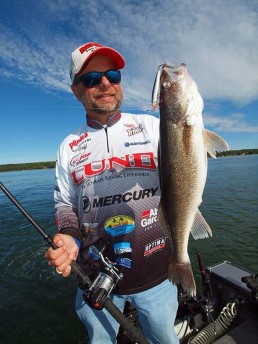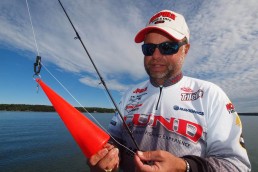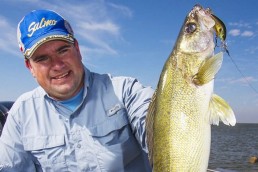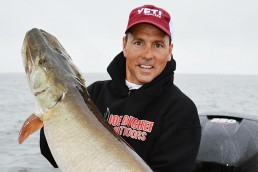Trolling Late in the Season
SHARE THIS POST
Before the walleye season starts, the options for fishing them are anything but plentiful. In spring, the bite is limited due to most waters not being open for fishing yet, with exceptions. The same holds true late during the last of the open-water period. Now, the fish are congregating more in tighter-knit packs than they have been earlier in the year. With the season still open, there’s no time like the present to hit a couple of miles of water before the great freeze. And interestingly enough, the same places you found ‘eyes in April are the same places where you can find them in November.
Where fish? There fish!
Around the rivers, reefs and adjacent depths is where walleyes congregate in April, and these are the same places to look in now. In spring, it’s more the spawn that has them migrating here; in fall, it’s all about the food. Trolling is the ticket, not only for putting bait in front of more predators, but also to stand out from the crowd of smelt, alewives, gizzard shad and gobies. This is where the big ones live, often suspended over open water or moving onto rock-strewn areas to feed.
In the daylight
In my early years fishing with my grandfather and father around the Muskegon Lake river mouth in Michigan, we caught monster walleyes trolling near the beach and around the pier heads. The pattern still holds true, but since then I’ve found even greater numbers within a 2-mile radius of this river mouth, as is the case from the Muskegon to Erie’s Maumee and any inland lake with similar attributes.
During the day I’ll look with electronics for bait and then troll for suspended fish that may be down 10 to 25 feet. Most of the time you’ll see the bait, but unless the walleyes are highly concentrated, you’ll seldom see fish. Still, I’ll put my lines out so my crankbaits are running atop the schools of bait, especially since predators such as walleyes tend to look up and not down when pursuing their prey. When I spot a blob of bait on my Lowrance HDS Gen-3 unit with GPS, I’ll punch in a waypoint or an icon for future reference.
As I’m trolling, I’ll often identify four or five key schools of bait and then troll in between them. Sometimes only one or two of the schools are holding walleyes, so you have to cover water to find out.
Speed control and the right lures are keys to connecting. I troll with my 9.9-hp, four-stroke kicker, which pushes my big Lund at a slow crawl. My favorite speed during the daytime is about 1.5 mph. At this pace, I get solid action out of Rapala Down Deep Husky Jerks, slim minnow baits that achieve excellent depth and have a light wobble that triggers fish in cold water. If I can’t get the suspended fish going or if I mark some big arcs near the bottom, I’ll then switch over to leadcore and to the new Scatter Raps and get the cranks within 1 or 2 feet of the bottom. But make sure you watch the locator and pay close attention to the depth.
The beauty of leadcore is that if the bottom rises you can simply speed up and the line will lift above a hump or ledge. When you get past it, count to 30 and then slow down. The leadcore will sink back into the walleye’s range.
Tools of the trolling trade
Planer boards are incredibly important to spread lines to the side where fish scoot out to after your boat goes over them. The walleyes simply move right into the path of the lures. Stern planers are also part of my spread.
For smaller-running cranks, check out Church Tackle’s TX-12. They also have ones that work with deeper, harder-diving crankbaits. In serious winds, the TX-24 has accompanying ballast, which rides the waves with no problem. Church’s Stern Planers also allow for line-out/depth precision while allowing the lures to run several hundred feet behind the boat without tangling up.
Are you enjoying this post?
You can be among the first to get the latest info on where to go, what to use and how to use it!
Sometimes it’s best to go especially slow, right around 1 mph. And while cooling waters might not be the best, crankbaits with more wobble, such as the Rapala Tail Dancer and the new Scatter Rap, provide more erratic side-to-side movement to set your offering apart from the hordes of baitfish.
When night falls
At night the waters come alive with even more monsters, which feed under the cover of darkness. The same trolling techniques are the way to go. Move from one baitfish pod to another, but make adjustments because the fish certainly will.
In darkness, walleyes tend to move higher in the water column, up into the top 10 feet. This is the time to switch from the gas kicker to a powerful trolling motor that has quality batteries and will ease along at 1 mph. My 107-pound thrust bow-mount draws little juice from my dependable Optima batteries. Now I can troll all night long with plenty of power.
When I have tried trolling with the gas motor I’ve caught fish the first few passes and then had them turn off because of the noise. With the electric, I keep catching them. To work up higher toward the surface, I switch to number 13 Original Rapalas on 20-pound-test Berkley FireLine. Three number 7 split shot a few feet above it will get you down to 12 or 13 feet. The split shot will also stop any weeds—now dying and floating on the surface—from sliding farther down my line than where they are pinched at, rendering my Rapalas useless.
I seldom use planer boards at night, but if you must, keep small boards close to the boat and just beyond your other rods to prevent congestion and bottlenecks with others who are trolling. Another reason to go without boards is the ability to pump the Rapala forward and drop it back, which is a key trigger. Slowly ease the rod forward about 18 inches and drop it back on a tight line. I do this about 20 or 30 times a minute. Keep it gentle, however, otherwise you’ll pull the lure away from too many walleyes, which miss when the bait has too much erratic action.
Earlier this year was feast or famine, and November can be that as well. But now is the time to make your move before you’re walking on water rather than boating on it.
Mark Martin is a professional walleye tournament angler and instructor with the Ice Fishing School/Vacation series. Check out his website at markmartins.net or fishingvacationschool.com for more information.
MWO
SHARE THIS POST
Did you enjoy this post?
You can be among the first to get the latest info on where to go, what to use and how to use it!
Mark Martin
Mark Martin is a professional walleye tournament angler and instructor with the Ice Fishing School/Vacation series. For more information, check out his website at markmartins.net or fishingvacationschool.com.




